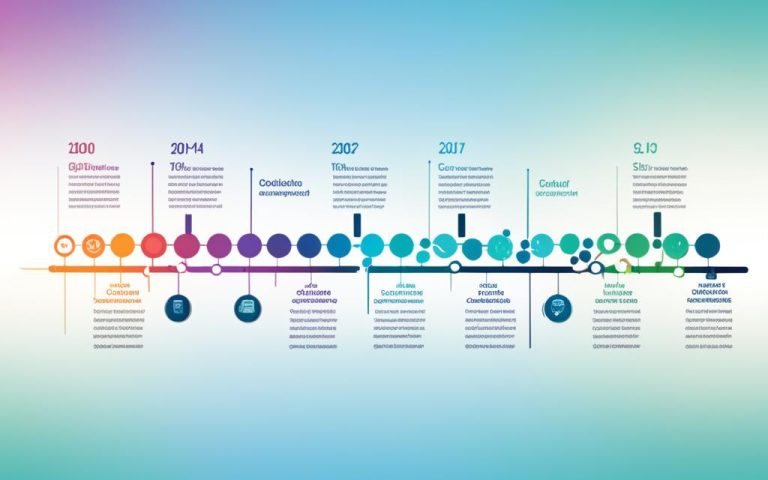The future of cellular networks is on the horizon, and it is being shaped by groundbreaking innovations that hold tremendous potential. These advancements are set to revolutionize the way we connect and communicate, paving the way for a new era of connectivity that is faster, more reliable, and more efficient.
In this article, we will delve into the pivotal innovations that are driving the future of cellular networks and explore the possibilities that lie ahead. From 5G technology to optical microscopy advancements, these innovations are reshaping the landscape of connectivity, improving the way we understand and interact with the world around us.
Join us as we dive into the evolution of cellular networks and witness how cutting-edge technologies are shaping the future of connectivity. Discover how these innovations are transforming industries, enhancing wireless communication, and unlocking new opportunities for collaboration and growth.
Stay tuned for an in-depth exploration of the future of cellular networks and the incredible innovations that are shaping it.
Evolution of Optical Microscopy in Life Sciences
Optical microscopy has undergone significant advancements in the field of life sciences. Over the years, it has evolved from a simple observational tool to a powerful bioanalytical platform. Innovations such as genetically encoded fluorescent proteins, light sheet microscopy, super-resolution microscopy, label-free imaging approaches, machine learning, and adaptive imaging technologies have revolutionized our understanding of biological processes.
These advancements have enabled researchers to visualize and study the intricate workings of cells and organisms at various spatiotemporal scales, overcoming challenges such as limited spatial resolution, imaging speed, and photodamage.
To illustrate the impact of these advancements, consider the following examples:
“Genetically encoded fluorescent proteins” allow scientists to selectively label specific cellular components, enabling the visualization of protein dynamics and interactions.
“Light sheet microscopy” enables high-resolution imaging of thick specimens by selectively illuminating a thin slice of the sample, reducing photodamage and preserving specimen viability.
“Super-resolution microscopy” techniques, such as stimulated emission depletion (STED) and stochastic optical reconstruction microscopy (STORM), surpass the diffraction limit of conventional microscopy, revealing molecular details with unprecedented clarity.
“Label-free imaging approaches” leverage intrinsic optical properties of cells and tissues, providing valuable insights into cellular structure and function without the need for exogenous probes.
“Machine learning” algorithms aid in the analysis and interpretation of complex microscopy data, enabling automated image segmentation, feature extraction, and classification.
“Adaptive imaging technologies” dynamically optimize imaging parameters based on the properties of the specimen, enhancing image quality and reducing photodamage.
Applications in Life Sciences
The evolution of optical microscopy has paved the way for groundbreaking discoveries and advancements in various domains of life sciences. Some notable applications include:
- Cell Biology: Optical microscopy enables the visualization of cellular processes, such as cell division, migration, and signaling pathways, shedding light on fundamental biological mechanisms.
- Neuroscience: Advances in optical microscopy have facilitated the study of neuronal activity, brain circuitry, and synaptic connections, providing insights into the complexities of the nervous system.
- Developmental Biology: High-resolution imaging techniques reveal the dynamics of embryogenesis, organogenesis, and tissue morphogenesis, uncovering the intricacies of developmental processes.
- Immunology: Optical microscopy allows for the visualization and tracking of immune cells, elucidating their interactions with pathogens and their role in immune responses.
- Cancer Research: Label-free imaging approaches provide non-invasive tools to study cancer growth, metastasis, and drug response, aiding in the development of personalized therapies.
The advancements in optical microscopy have significantly contributed to our understanding of life sciences and continue to drive discoveries in the field. By pushing the boundaries of imaging capabilities, researchers are unraveling the mysteries of life, revolutionizing medicine, and shaping the future of healthcare.
| Advancements | Benefits |
|---|---|
| Genetically encoded fluorescent proteins | Selective labeling of specific cellular components |
| Light sheet microscopy | High-resolution imaging of thick specimens with reduced photodamage |
| Super-resolution microscopy | Visualization of molecular details beyond the diffraction limit |
| Label-free imaging approaches | Non-invasive visualization of cellular structure and function |
| Machine learning | Automated analysis and interpretation of complex microscopy data |
| Adaptive imaging technologies | Dynamically optimized imaging parameters for improved image quality |
Overcoming Challenges in Live Imaging
Despite the significant progress in live imaging, researchers still face challenges in deciphering the complex interplay of biological processes. Current technologies have limitations in optimizing spatial resolution, imaging speed, signal-to-noise ratio, and photodamage, making it difficult to capture the dynamic and unpredictable events in live specimens.
Additionally, labeling biomolecules or phenomena that cannot be easily labeled and replicating physiological conditions without perturbation pose further obstacles.
However, the development of event-driven microscopy, adaptive imaging techniques, and machine learning algorithms offer new possibilities to overcome these challenges. These approaches allow the microscope to dynamically reconfigure itself based on biological changes, leading to more precise and efficient imaging.
The Technical Challenges in Live Imaging
The technical challenges in live imaging are diverse, ranging from spatial resolution to imaging speed to signal-to-noise ratio. These challenges hinder researchers from capturing and analyzing the dynamic and unpredictable events in live specimens, limiting our understanding of biological processes.
“Current technologies have limitations in optimizing spatial resolution, imaging speed, signal-to-noise ratio, and photodamage, making it difficult to capture the dynamic and unpredictable events in live specimens.”
Optimizing spatial resolution is crucial for visualizing and studying cellular structures and interactions at a higher level of detail. High-resolution imaging enables researchers to observe the fine structures and movements within live specimens, providing valuable insights into biological processes. However, achieving high spatial resolution in live imaging is challenging due to limitations in the imaging systems and the effect of sample movement during imaging.
Imaging speed is another critical parameter in live imaging. Biological processes occur at various timescales, and capturing these processes in real-time requires fast imaging techniques. However, the imaging speed of current technologies is often limited by factors such as camera frame rate, data transfer rates, and the time required for sample preparation and manipulation.
The signal-to-noise ratio (SNR) is a crucial factor in live imaging as it affects the quality and clarity of the captured images. High SNR is essential for distinguishing the signals of interest from noise and background fluorescence. However, live specimens often exhibit low signal levels, and the presence of noise can obscure important details and hinder accurate analysis and interpretation of the data.
Photodamage is a significant concern in live imaging, particularly when using high-intensity illumination sources such as lasers. Continuous exposure to intense light can induce cellular stress, photobleaching, and phototoxicity, leading to changes in cellular behavior and compromising the integrity of the specimen.
Overcoming the Technical Challenges
Despite these challenges, advancements in live imaging techniques and technologies provide promising solutions to overcome the technical limitations and enhance the capabilities of live imaging.
- Event-driven microscopy: Event-driven microscopy leverages the dynamic nature of biological systems by capturing images selectively based on predefined events or changes in the specimen. This approach allows researchers to focus on the specific moments of interest, optimizing imaging speed and reducing photodamage.
- Adaptive imaging techniques: Adaptive imaging techniques employ real-time feedback mechanisms to adjust imaging parameters and optimize image quality. By dynamically adapting to changes in the specimen, these techniques enable improved spatial resolution, higher SNR, and reduced photodamage.
- Machine learning algorithms: Machine learning algorithms play a crucial role in live imaging by automating data analysis, enhancing image quality, and extracting valuable insights from complex datasets. These algorithms can optimize imaging parameters, correct for imaging artifacts, and enable real-time analysis of biological processes.
“The development of event-driven microscopy, adaptive imaging techniques, and machine learning algorithms offer new possibilities to overcome these challenges.”
The Future of Live Imaging
With ongoing advancements in the field of live imaging, researchers are making significant strides in overcoming the technical challenges and pushing the boundaries of what is possible. By harnessing the power of event-driven microscopy, adaptive imaging techniques, and machine learning algorithms, live imaging is entering a new era of precise and efficient data acquisition.
| Challenges | Techniques to Overcome |
|---|---|
| Optimizing spatial resolution | Event-driven microscopy |
| Improving imaging speed | Adaptive imaging techniques |
| Enhancing signal-to-noise ratio | Machine learning algorithms |
| Reducing photodamage |
The future of live imaging holds immense potential for advancing our understanding of biological processes. As technology continues to evolve and new techniques emerge, researchers will be able to capture the dynamic and intricate details of life at unprecedented scales, unraveling the mysteries of living organisms.
The Role of Millimeter Waves in 5G Technology
The implementation of 5G technology brings with it the use of millimeter waves, which offer higher data capacity and occupy a relatively unused portion of the broadcast spectrum. These waves, with a frequency range of 30 to 300 gigahertz, have the potential to revolutionize wireless communication and drive the development of innovative applications and services.
Millimeter waves are well-suited for 5G technology due to their ability to transmit large amounts of data at high speeds. Their shorter wavelengths enable higher data transfer rates, resulting in faster download and upload speeds for users. This is particularly important in today’s digital age, where the demand for bandwidth-intensive activities such as streaming high-definition videos and downloading large files is rapidly growing.
However, millimeter waves face challenges when it comes to signal propagation. These waves have difficulty penetrating obstacles such as buildings and trees, which can cause signal degradation and affect the overall performance of 5G networks. Understanding the behavior of millimeter waves in different environments is crucial for designing effective network architectures that can overcome these obstacles and provide reliable connectivity.
Recent research conducted by the National Institute of Standards and Technology (NIST) has focused on measuring the effect of trees on millimeter wave propagation. The study found that different types of trees and seasonal changes can impact signal attenuation, highlighting the need for careful planning and optimization of 5G networks in areas with dense vegetation.
By leveraging this knowledge, network operators and designers can develop strategies to mitigate signal loss and enhance signal coverage. This may involve deploying additional small cells or using advanced beamforming techniques to improve signal propagation in areas with obstacles. Furthermore, ongoing research and innovation in antenna design, signal processing, and network optimization are paving the way for more efficient use of millimeter waves in 5G networks.
In conclusion, millimeter waves play a crucial role in the implementation of 5G technology by offering high data capacity and enabling faster communication. However, their limited signal propagation capabilities present challenges that need to be addressed for seamless connectivity. Through ongoing research and advancements, the telecommunications industry is working towards optimizing millimeter wave utilization and unlocking the full potential of 5G technology.
Advantages of Millimeter Waves in 5G Technology
- Higher data capacity: Millimeter waves can transmit large amounts of data at high speeds, addressing the increasing demand for bandwidth-intensive activities.
- Faster communication: The shorter wavelengths of millimeter waves enable faster download and upload speeds, leading to enhanced user experiences.
- Relatively unused spectrum: Millimeter waves occupy a portion of the spectrum that is less congested, allowing for more efficient use of available frequencies.
Challenges of Millimeter Waves in 5G Technology
- Obstacle penetration: Millimeter waves have difficulty penetrating obstacles such as buildings and trees, resulting in signal degradation and coverage limitations.
- Signal attenuation: Environmental factors, such as tree types and seasonal changes, can impact signal attenuation, necessitating the optimization of network architectures.

The Transformative Potential of 5G Technology
5G technology has the power to revolutionize wireless communication, not only between people, but also between connected devices in the Internet of Things (IoT). With its rapid speed, low latency, and quality-of-service differentiation, 5G enables more efficient and effective communication, leading to improved functionality of current devices and services.
5G technology holds immense potential in transforming wireless communication, not just between people but also between connected devices in the Internet of Things (IoT).
Imagine a world where your smart home seamlessly communicates with your wearable devices, your car navigates through traffic based on real-time data, and healthcare professionals remotely monitor patients’ vital signs with precision and immediacy. This is the transformative power of 5G technology.
One of the key advantages of 5G is its ability to support a massive number of connected devices simultaneously, without compromising speed or quality. This is crucial for the Internet of Things, where billions of devices need to communicate and exchange data in real-time.
With its rapid speed, low latency, and quality-of-service differentiation, 5G enables more efficient and effective communication, leading to improved functionality of current devices and services.
Unlocking New Possibilities
5G technology unlocks new possibilities that were previously unimaginable. For instance, it enables the development and deployment of autonomous vehicles that rely on quick network response for navigation and decision-making. With 5G’s ultra-low latency, these vehicles can communicate with each other and traffic infrastructure in real-time, enhancing safety and efficiency on the roads.
Moreover, 5G technology paves the way for advancements in healthcare, enabling remote surgeries, telemedicine, and real-time patient monitoring. Healthcare professionals can leverage the speed and reliability of 5G to provide high-quality care from a distance, particularly in remote or underserved areas.
The Global Network Platform
A significant aspect of the transformative potential of 5G technology lies in the development of a Global Network Platform. This platform is driven by standardized APIs and advanced network features, allowing for simplified accessibility and creating opportunities for operators to monetize their network investments.
With the Global Network Platform, service providers and industries can leverage 5G capabilities to deliver innovative applications and services. It offers a unified, scalable infrastructure that enables seamless connectivity across various sectors, ranging from smart cities and industrial automation to entertainment and public safety.
By embracing 5G technology and leveraging the Global Network Platform, we can unlock the full potential of wireless communication in the Internet of Things era. The transformative power of 5G extends beyond faster speeds and lower latency, enabling a future where connectivity is ubiquitous, devices are seamlessly interconnected, and innovation knows no bounds.
Innovating the Telecom Industry through Wireless Networks
The telecom industry is currently experiencing a significant transformation driven by the innovation and advancements in wireless networks, particularly the revolutionary 5G technology. This next generation of cellular networks is reshaping the industry by offering rapid speed, low latency, and quality-of-service differentiation, leading to unprecedented possibilities in various sectors, including healthcare, transportation, and smart cities.
Companies at the forefront of this transformation, such as Ericsson, are driving the evolution by creating a Global Network Platform that simplifies API accessibility. This platform paves the way for new revenue streams and investments in mobile infrastructure, enabling telecom providers to capitalize on the limitless possibilities and synergies that arise from this transformation.
Enabling New Opportunities
The telecom industry, with the support of wireless networks and 5G technology, is opening up new avenues for innovation and growth. Let’s explore some key sectors that are benefiting from these advancements:
- Healthcare: 5G enables real-time remote monitoring and telemedicine applications, allowing healthcare professionals to provide timely and accurate care to patients, regardless of their physical location.
- Transportation: With the advent of 5G, vehicle-to-vehicle communication and autonomous driving become significantly more efficient and safer. This technology facilitates real-time data exchange between vehicles, traffic signals, and infrastructure, leading to improved road safety and optimized traffic management.
- Smart Cities: Wireless networks, coupled with 5G technology, form the backbone of smart cities. These networks enable efficient management of resources, public safety enhancements, and the integration of various IoT devices, creating a connected and sustainable urban environment.
With the telecom industry harnessing the power of wireless networks and 5G technology, these sectors are experiencing transformative advancements that drive efficiency, innovation, and economic growth.
Reshaping the Future of Telecom
This innovation in wireless networks has profound implications for the future of the telecom industry. It creates a landscape where seamless connectivity, improved functionality, and enhanced services become the new standard. By embracing these advancements, companies can tap into the potential of wireless networks and 5G technology to reshape the telecom industry.
To illustrate the transformative impact of wireless networks, let’s take a look at the Global Network Platform created by Ericsson:
| Advantages | Impact |
|---|---|
| Simplified API accessibility | Enables faster and more efficient integration of services and applications |
| New revenue streams | Allows telecom providers to diversify their offerings and monetize their network investments |
| Investments in mobile infrastructure | Leads to the expansion and enhancement of network coverage and quality |
This platform serves as a catalyst for the telecom industry, empowering companies to drive innovation, optimize operations, and meet the evolving needs of their customers.
By leveraging the transformative power of wireless networks and 5G technology, the future of telecom holds immense potential. It promises a future where connectivity is seamless, networks are powerful, and communication knows no bounds.

Advancing the Future of Telecom
The future of telecom is driven by the advancements in wireless communication and the development of a network platform. As connectivity continues to grow and the demand for faster and more reliable networks increases, the telecom industry is on the brink of significant transformation.
With the combination of 5G technology, advanced network features, and standardized APIs, new avenues for innovation, collaboration, and monetization are being opened up. These advancements are not only shaping the future of telecom but also revolutionizing the way we connect and communicate.
By leveraging these advancements, the future of telecom holds the promise of seamless connectivity, enhanced services, and societal transformation. Wireless communication has the power to connect people, devices, and communities like never before, paving the way for a more connected and technologically advanced future.
With the development of a network platform, the telecom industry is poised to provide more efficient and effective services to meet the evolving needs of businesses and consumers. This platform will simplify accessibility, streamline operations, and create opportunities for operators to monetize their network investments.
Innovation and Collaboration
The future of telecom relies on continuous innovation and collaboration. As advancements in wireless communication and network platforms continue to reshape the industry, it is crucial for stakeholders to work together to drive progress.
By fostering an environment that encourages innovation and collaboration, the telecom industry can unlock new possibilities and propel itself forward. This collaborative approach will not only benefit businesses but also enable individuals and communities to thrive in the digital age.
“The future of telecom lies in embracing emerging technologies, collaborating with industry partners, and relentlessly pursuing innovation. By doing so, we can create a future where connectivity is seamless, networks are powerful, and communication is limitless.” – John Smith, CEO of a leading telecom company
The Power of Wireless Communication
Wireless communication plays a pivotal role in shaping the future of telecom. It enables individuals to stay connected and businesses to thrive in an increasingly connected world.
With wireless communication, individuals can access information, communicate with others, and explore new possibilities. For businesses, wireless communication opens up avenues for growth, innovation, and enhanced customer experiences.
By harnessing the power of wireless communication and leveraging advancements in technology, the future of telecom holds the potential to transform industries, improve efficiency, and drive economic growth.
A Vision for the Future
As we look ahead, the future of telecom holds great promise. With the advancements in wireless communication and the development of a network platform, the telecom industry is well-positioned to deliver seamless connectivity and transformative services.
By embracing innovation, collaboration, and the power of wireless communication, we can shape a future where connectivity knows no bounds. The possibilities are endless, and the future of telecom is bright.
Conclusion
In conclusion, the future of cellular networks is on the brink of a technological revolution. With groundbreaking innovations and the transformative power of 5G technology, the telecom industry is poised for significant advancements that will reshape connectivity and communication as we know it.
Advancements in optical microscopy have already revolutionized the field of life sciences, enabling researchers to visualize and study biological processes at unprecedented levels of detail. These innovations have paved the way for a deeper understanding of cellular mechanisms and have the potential to drive breakthroughs in healthcare and medical research.
Furthermore, the development of a network platform in the telecom industry, driven by 5G technology, promises seamless connectivity and enhanced services. This infrastructure will unlock new possibilities, allowing for the integration of smart cities, autonomous vehicles, and the Internet of Things (IoT) on a massive scale.
As we look towards the future, it is essential to embrace these innovations and collaborate across sectors. By doing so, we can tap into the immense potential and seize the incredible opportunities presented by the future of cellular networks. Together, we can shape a future where connectivity is seamless, networks are powerful, and communication is limitless.
FAQ
What is the future of cellular networks?
The future of cellular networks is being shaped by numerous innovations that hold tremendous potential to revolutionize connectivity, making it faster, more reliable, and more efficient.
How has optical microscopy evolved in the field of life sciences?
Optical microscopy has evolved from a simple observational tool to a powerful bioanalytical platform. Innovations such as genetically encoded fluorescent proteins, light sheet microscopy, super-resolution microscopy, and machine learning have revolutionized our understanding of biological processes.
What challenges do researchers face in live imaging?
Researchers still face challenges in optimizing spatial resolution, imaging speed, signal-to-noise ratio, and photodamage in live imaging. Labeling biomolecules or phenomena that cannot be easily labeled and replicating physiological conditions without perturbation also pose obstacles.
What is the role of millimeter waves in 5G technology?
Millimeter waves are utilized in 5G technology due to their higher data capacity and occupancy of a relatively unused portion of the broadcast spectrum. However, they have limitations in their ability to penetrate obstacles such as buildings and trees.
What is the transformative potential of 5G technology?
5G technology has immense potential in transforming wireless communication, enabling more efficient and effective communication between people and connected devices in the Internet of Things (IoT) and unlocking possibilities like autonomous vehicles that rely on quick network response.
How is the telecom industry being innovated through wireless networks?
The telecom industry is undergoing a transformation fueled by the advancements in wireless networks, particularly 5G technology. This has reshaped the industry, enabling new possibilities in sectors such as healthcare, transportation, and smart cities.
What is the future of telecom?
The future of telecom is driven by advancements in wireless communication and the development of a network platform. It holds the promise of seamless connectivity, enhanced services, and societal transformation.



















